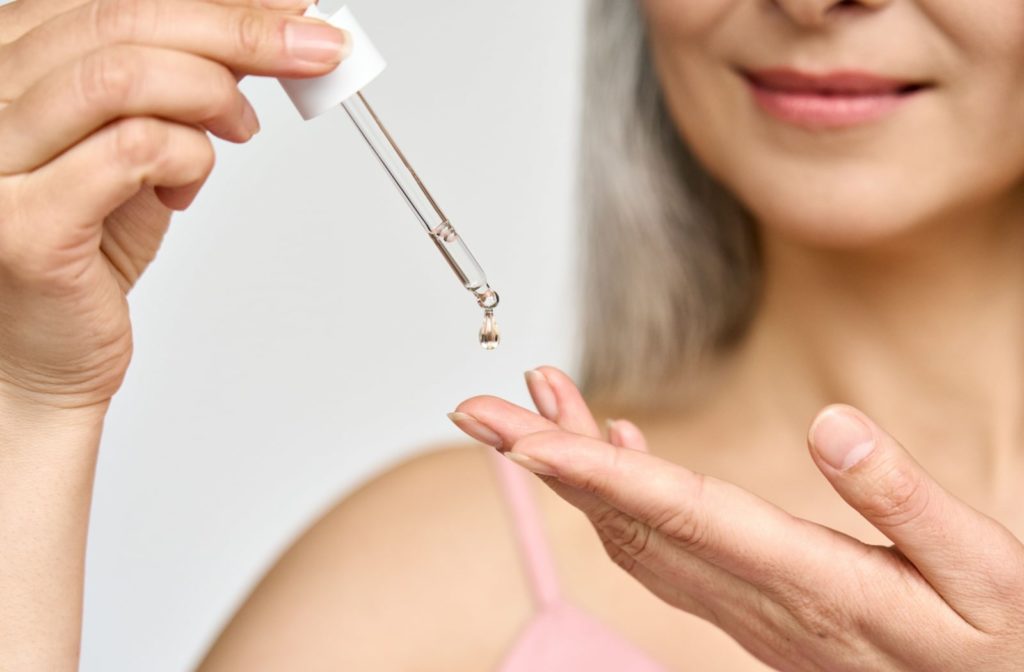Navigating the skincare aisle can be as perplexing as decoding a cryptic crossword. For those with rosacea, it’s even trickier.
Enter hyaluronic acid (HA)—the hydrating hero you’ve probably heard whispers about at your local skincare haunt.
Dermatologists often recommend HA to treat rosacea because it can provide moisture for parched skin and, when used as part of a customized skincare routine, may improve your complexion.
If you’re considering using HA as part of your skincare routine, visit our sister company, Retuva Medical Spa so you can talk to a trusted skincare professional.
Rosacea: The Blushing Beauty
Rosacea is a chronic skin condition characterized by redness, swelling, and pesky pimples. It can make your skin feel very sensitive. People with rosacea may have to tiptoe around triggers like the sun, spicy foods, and stress.
Hyaluronic Acid: The Skincare Superhero
Hyaluronic acid sounds like something created in a mad scientist’s lab. Despite its name, HA is a naturally occurring molecule that’s quite popular in dermatology circles. HA is excellent for hydration, as it can hold up to a thousand times its weight in water.
Imagine HA as the sponge of skincare—it absorbs moisture and holds it in. It’s stellar for turning your parched skin into an oasis and is superb for anti-aging because it helps smooth out fine lines. It’s also gentle for most skin types because it’s already a part of what your skin is made of.
Can You Use Hyaluronic Acid on Rosacea?
Applying HA to rosacea skin is like giving your face a cool, calming drink. Because HA is inherently gentle and calming, it’s a go-to for many people who have sensitive skin due to rosacea. It helps your complexion by moisturizing without clogging pores or inviting irritants to wreak havoc on your delicate skin.
Benefits of Using Hyaluronic Acid for Rosacea
From plumping effects to quenching thirsty skin cells and reducing the appearance of lines, HA can be a gentle fortress against the elements. In addition to being a powerful hydrating ingredient, hyaluronic acid has also been shown to have anti-aging benefits, helping improve the appearance of fine lines.
And remember, incorporating HA doesn’t mean you need to bid farewell to other treatments. HA can also work with prescription topicals and other soothing agents.
How to Incorporate HA into Your Daily Skin Care Routine
1. Start with a clean canvas: Before applying any skincare product, make sure your face is clean and free of any makeup or dirt.
2. Apply toner: After cleansing, apply a hydrating toner to prep your skin for HA absorption.
3. Use a water-based HA serum: Look for serums that contain pure hyaluronic acid as the main ingredient. Apply a few drops onto your fingertips and gently pat it into your skin.
4. Lock it in: Seal in the benefits with a moisturizer on top of the HA serum. This can prevent moisture loss throughout the day.
5. Use sunscreen: UV rays can weaken HA’s ability to retain water in our skin. Make sure to use a broad-spectrum sunscreen with at least SPF 30 every day.
6. Don’t overdo it: While HA is safe for daily use, using too much of it can actually have the opposite effect and dry out your skin. Stick to using 1 or 2 products containing HA in your routine.
7. Consider different forms of HA: If serums aren’t your thing, don’t worry! There are other ways to incorporate HA into your skincare routine. Look for moisturizers, face masks, and makeup products that contain HA.
8. Monitor results: Everyone’s skin is unique, so it may take some trial and error to find the right form and amount of HA for you. Pay attention to how your skin feels and looks after using HA products, and adjust accordingly.
Consistency is key to seeing results from any skincare product. So make sure to incorporate HA into your routine every day for hydrated, plump skin!
Potential Side Effects
Some potential side effects of HA include redness and allergic reactions. Always introduce HA to your skincare routine with a patch test for compatibility.
What Else Can I Use for Treating Rosacea?
“Variety is the spice of life,” but when you’ve got rosacea, spice is precisely what you want to avoid. Opt for soothing companions like aloe vera, niacinamide, and ceramides.
Remember to always patch test a new product before using it all over the affected area—your skin will thank you for your caution.
The Battle for Clearer Skin
Championing your skin’s health may require trial and error and a lot of patience. For those with rosacea, HA offers a promising array of benefits. While HA might not be a cure-all, it stands a good chance of being your solution for rosacea relief. For more information, contact us at Family Focus Eyecare or schedule a free consult and skin mapping with our sister company, Retuva Medical Spa. We can tackle your rosacea together.



